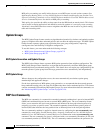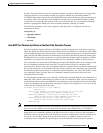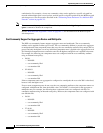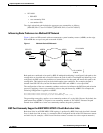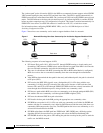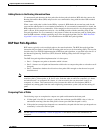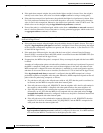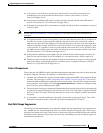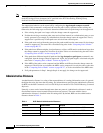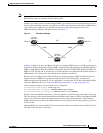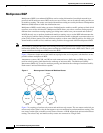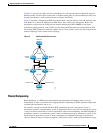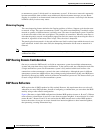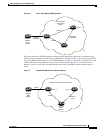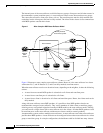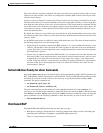
Implementing BGP on Cisco IOS XR Software
Information About Implementing BGP on Cisco IOS XR Software
RC-30
Cisco IOS XR Routing Configuration Guide
OL-14356-01
Note This suppression behavior does not comply with the IETF Networking Working Group
draft-ietf-idr-bgp4-24.txt document, but is specified in the IETF Networking Working Group
draft-ietf-idr-avoid-transition-00.txt document.
The suppression behavior can be turned off by configuring the bgp bestpath compare-routerid
command. If this command is configured, the new best path is always preferred to the existing one.
Otherwise, the following steps are used to determine whether the best-path change can be suppressed:
1. If the existing best path is no longer valid, the change cannot be suppressed.
2. If either the existing or new best paths were received from internal (or confederation) peers or were
locally generated (for example, by redistribution), then the change cannot be suppressed. That is,
suppression is possible only if both paths were received from external peers.
3. If the paths were received from the same peer (the paths would have the same router-id), the change
cannot be suppressed. The router ID is calculated using rules in the “Comparing Pairs of Paths”
section on page RC-27.
4. If the paths have different weights, local preferences, origins, or IGP metrics to their next hops, then
the change cannot be suppressed. Note that all of these values are calculated using the rules in the
“Comparing Pairs of Paths” section on page RC-27.
5. If the paths have different-length AS paths and the bgp bestpath as-path ignore command is not
configured, then the change cannot be suppressed. Again, the AS path length is calculated using the
rules in the “Comparing Pairs of Paths” section on page RC-27.
6. If the MED of the paths can be compared and the MEDs are different, then the change cannot be
suppressed. The decision as to whether the MEDs can be compared is exactly the same as the rules
in the “Comparing Pairs of Paths” section on page RC-27, as is the calculation of the MED value.
7. If all path parameters in Step 1 through Step 6 do not apply, the change can be suppressed.
Administrative Distance
An administrative distance is a rating of the trustworthiness of a routing information source. In general,
the higher the value, the lower the trust rating. For information on specifying the administrative distance
for BGP, see the BGP Commands on Cisco IOS XR Software module of Cisco IOS XR Routing Command
Reference.
Normally, a route can be learned through more than one protocol. Administrative distance is used to
discriminate between routes learned from more than one protocol. The route with the lowest
administrative distance is installed in the IP routing table. By default, BGP uses the administrative
distances shown in Table 1.
Table 1 BGP Default Administrative Distances
Distance Default Value Function
External 20 Applied to routes learned from eBGP.
Internal 200 Applied to routes learned from iBGP.
Local 200 Applied to routes originated by the router.



